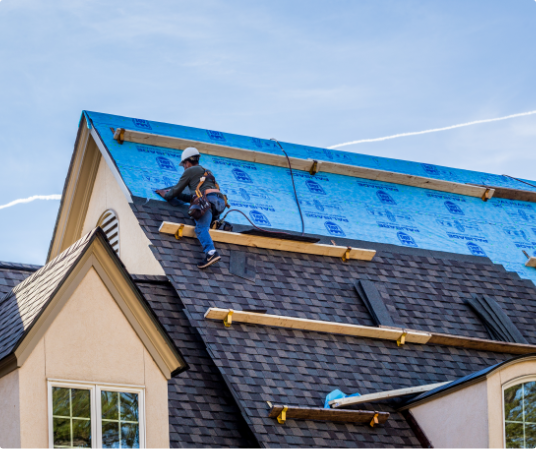Finest Practices for Ensuring Correct Roof Air Flow
Guaranteeing proper roof covering ventilation is important for the durability and efficiency of a roof covering system. A balanced consumption and exhaust vent ratio, frequently 1:300, plays a critical role, with intake vents ideally placed at the lower edge of the roof for cool air entrance and exhaust vents at the top for warm air leave. Regular examinations to recognize obstructions and preserve clear airflow are paramount. Maintaining insulation away from vents is crucial to stop airflow restriction. Comprehending these fundamental elements establishes the phase for more in-depth understandings right into installation and maintenance techniques that can dramatically enhance your roof covering system's efficiency.
Understand Ventilation Fundamentals
Correctly understanding air flow essentials is essential for making certain the longevity and efficiency of roof. Effective ventilation reduces dampness accumulation and temperature extremes in the attic, both of which can cause substantial architectural damage with time. A well-ventilated roof covering aids in protecting against typical problems such as mold development, timber rot, and ice dams, which can compromise the integrity of the roof covering products and the underlying frameworks.
The key objective of ventilation is to help with the activity of air, enabling a constant exchange between the outdoor and interior settings. This equilibrium is attained via a combination of intake and exhaust vents that interact to maintain optimum air flow. Consumption vents, generally located along the eaves or soffits, enable fresh air to get in the attic room area, while exhaust vents, commonly situated at or near the roofing system ridge, enable warm, humid air to escape.
Trick variables affecting the performance of roof covering ventilation consist of appropriate placement, sufficient sizing, and ensuring that both consumption and exhaust vents are unblocked. Regular examination and upkeep are essential to determine potential obstructions, damages, or inefficiencies in the air flow system, thereby guarding the roof covering's performance and durability.
Sorts Of Roofing Vents
Roof covering vents play an important duty in preserving effective attic air flow and, by expansion, the overall health and wellness of the roof. Different sorts of roofing vents are offered, each with special advantages customized to specific roof demands. Ridge vents, for instance, are mounted along the roof covering's height, allowing warm, moist air to get away from the attic. They supply constant air flow and blend flawlessly with the roofline, making them both efficient and visually pleasing.

Soffit vents are installed under the eaves and operate in tandem with roof vents to ensure a well balanced intake and exhaust system. By allowing cooler air to enter from below, soffit vents promote the expulsion of hot air via top vents. Gable vents, situated on the exterior wall surfaces of the attic, deal another reliable option, particularly in homes with gable roofings.
Analyze Your Existing Ventilation

Following, consider informative post the age and problem of your roof materials and ventilation parts. Older systems may not adhere to current building codes or might have degraded with time, reducing their effectiveness. Conduct an extensive assessment to recognize any type of indicators of deterioration, such as corrosion, damage, or voids that might jeopardize the system's efficiency.
Additionally, measure the attic room temperature and humidity degrees. Heats and moisture can indicate insufficient ventilation - roofing companies in gainesville florida. Utilize a hygrometer and thermostat to get accurate analyses, contrasting them with outdoor problems. Relentless disparities recommend potential problems that need dealing with.
Setup Best Practices
Efficient installment of roof covering ventilation systems is vital for guaranteeing optimum efficiency and long life. Appropriate installment starts with understanding the specific ventilation requirements of the building and the roofing it covers. This entails determining the appropriate ratio of intake to tire vents, usually adhering to the 1:300 guideline, which stipulates one square foot of ventilation for every single 300 square feet of attic room flooring room.

Intake vents must be installed at the roof covering's lower side, typically in the soffits, to enable trendy air to get in. Exhaust vents, on the other hand, ought to be mounted near or at the roofing system's peak to assist in the leave of cozy, damp air.
Seal all vent connections carefully to stop air leakages and possible water seepage. Use high-grade materials and follow maker standards to make certain toughness and efficiency. Furthermore, incorporating ridge vents with baffles can substantially improve air flow effectiveness by protecting against wind-driven rain and snow from entering the attic.
Ultimately, accurate installment of roofing ventilation systems reduces possible issues such as mold growth, ice dams, and structural damage, ensuring the roof's integrity and the structure's total health.
Regular Upkeep Tips
Consistency in upkeep methods is essential to guaranteeing the lasting efficiency of roofing air flow systems. Routine examinations are critical, preferably done biannually-- in the spring and loss. During these evaluations, ensure that vents are devoid of debris, nests, and other blockages that could hamper airflow. Examine for any type of signs of moisture buildup or mold and mildew, as these can suggest incorrect ventilation or leaks (roofing additional hints companies gainesville florida).
Utilize a soft brush or a vacuum cleaner to eliminate dirt and debris from intake and exhaust vents. Be careful not to harm the vent screens or louvers during the process.
Proper insulation is similarly vital. Make certain that attic room insulation does not block the vents, as this can severely restrict air movement. Rearrange or change it to keep an effective barrier. if any kind of insulation has moved or resolved.
Lastly, replace any kind of harmed or missing components quickly. Broken vents, broken roof shingles, or worn-out flashing can all add to inadequate ventilation and ought to be addressed right away. Normal upkeep guarantees that the roofing air flow system operates ideally, thus expanding the life-span of the roof covering itself.
Verdict
Making certain correct roof covering ventilation is extremely important for keeping the effectiveness and sturdiness of a roof. Adherence to the 1:300 intake and exhaust air vent ratio, coupled with the calculated placement of vents, is essential. Normal semiannual inspections, particles cleaning, and ensuring insulation does not block air flow are important methods. Implementing these ideal methods will certainly foster a well-ventilated roof covering system, thus reducing prospective concerns connected to moisture buildup and too much warmth, ultimately lengthening the roofing system's lifespan.
A well balanced intake and exhaust vent proportion, generally 1:300, plays an essential role, with intake vents preferably positioned at the reduced side of the roofing system for Discover More trendy air entrance and exhaust vents at the top for cozy air leave. Intake vents, normally located along the eaves or soffits, enable fresh air to get in the attic room area, while exhaust vents, usually situated at or near the roofing ridge, make it possible for warm, humid air to get away.
Soffit vents are mounted under the eaves and job in tandem with roofing system vents to make sure a well balanced consumption and exhaust system. By allowing cooler air to go into from below, soffit vents assist in the expulsion of warm air through top vents. Adherence to the 1:300 consumption and exhaust air vent proportion, combined with the calculated positioning of vents, is vital.